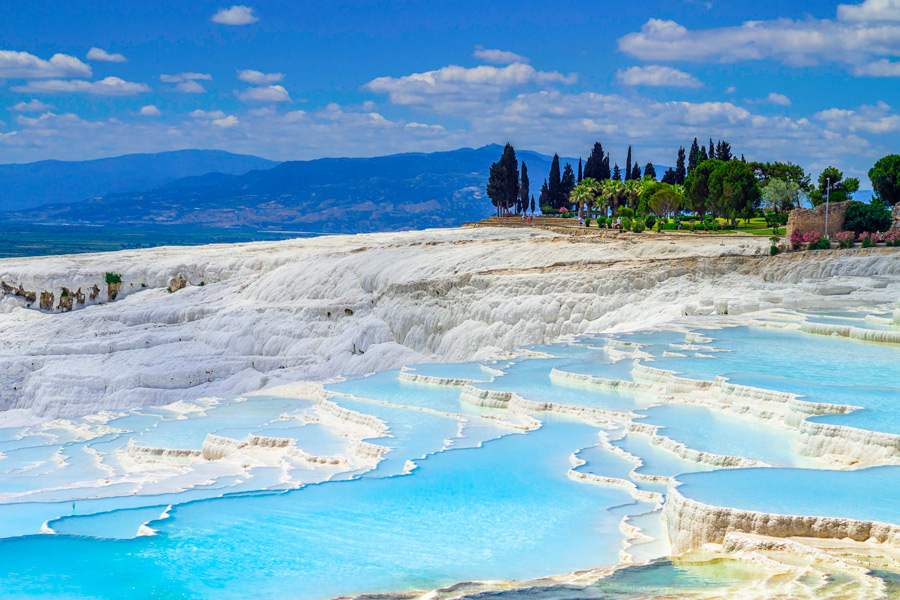
The top things to do in Pamukkale often include the thermal waters of the white travertine terraces (Cotton Castle) and the ancient city of Hierapolis. And speaking of the unique landmarks in Türkiye, this small countryside in Denizli Province of the Aegean region, approximately twenty kilometres from Denizli, is certainly a top contender. Many tourists come here only for one day, following a short flight from Istanbul or Antalya. What is so wonderful, however, is that they can see beyond the usual highlights because Pamukkale has much more to see, hear, and smell.
12 Spectacular Places to Visit in Pamukkale
One should forget about the standard Pamukkale tours. Aside from a great splash of white grandeur, the region invites sightseers to feel its variety and localness. This assumes travelling a bit further to approach the village of Karahayıt, the fragrant Gözler Lavender Gardens, or the magic Kaklık Cave. These Pamukkale attractions unveil a different side of the region, showing how rich and beautiful rural Turkey is. It only takes a short day trip on a Turkey travel to appreciate Pamukkale’s generosity in nature, history, and local culture.
Hierapolis Ancient City
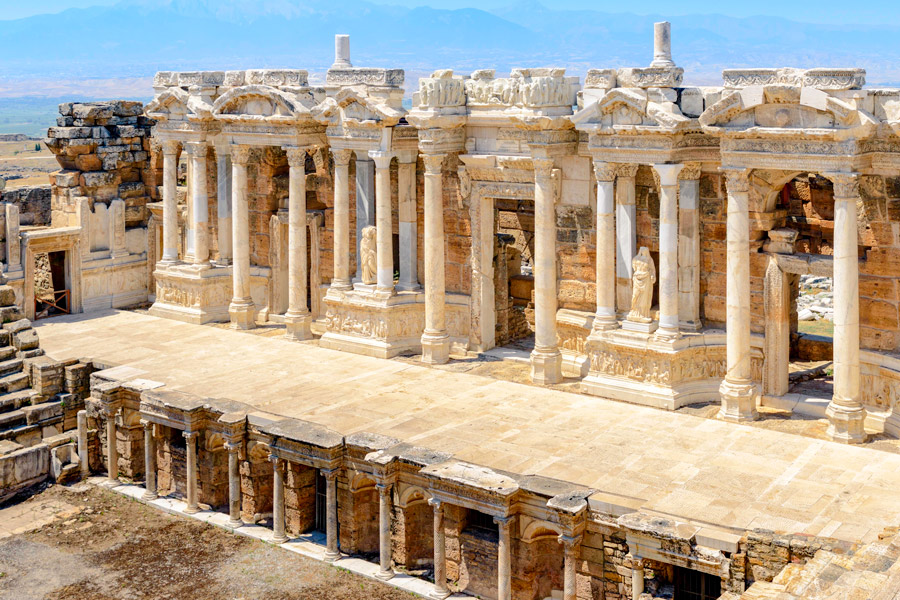
Uncover Centuries-Old Ruins of Pamukkale
Above the terraces lies Hierapolis (Hierapolis Antik Kenti), an ancient Greco-Roman spa city famed for its healing springs and sacred sites. Key Pamukkale historical sites encompass the Frontinus and North Byzantine Gates, the monumental theatre with panoramic views, the vast necropolis, and the Temple of Apollo. The Plutonium Cave – once believed to be an entrance to the underworld – adds a mythic layer. Strolling along its marble streets gives insight into why this was among the earliest health resorts in the ancient world.
Pro Tip: The entry fee for Pamukkale travertines and Hierapolis is around €30, but it is free with a Museum Card. Expect an extra charge for the headphones. To avoid the intense heat and large crowds, visit during the spring or autumn months.
Pamukkale Travertines (Cotton Castle)
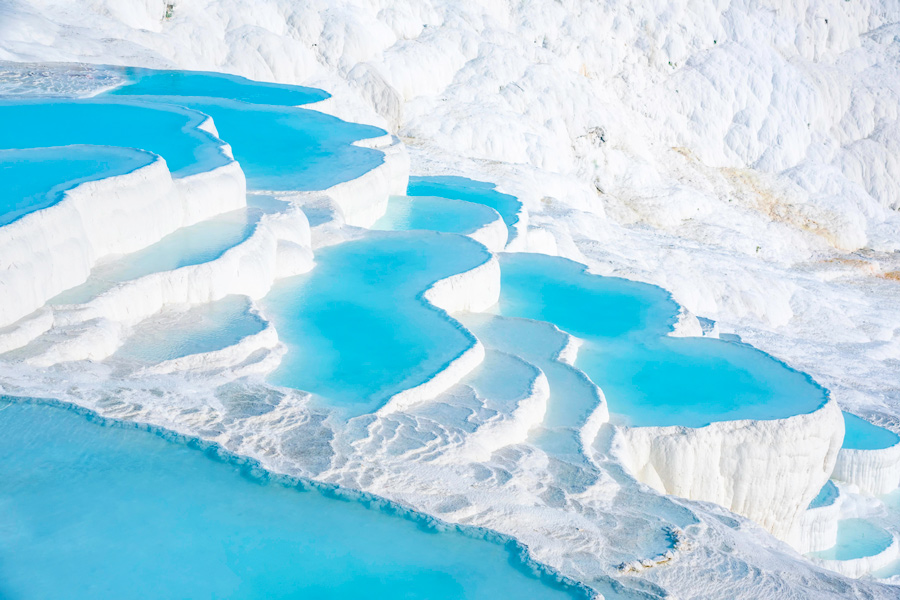
Walk Barefoot Across the Thermal Pools and Soak in Warm Mineral Waters
The largest natural attractions in Türkiye are Pamukkale’s white travertine terraces, known as the Cotton Castle. The Turkish name says it all: “Pamuk” means cotton, and “kale” means castle. The white cliffs appear like cascading clouds from afar, giving the area its poetic name.
Spending time in these calcium-rich hot springs that have flowed down the hillside for thousands of years is believed to offer health benefits. And coupled with the unique cotton-like landscape, it is one of the best places to visit in Pamukkale. Together with the adjacent Hierapolis, it has been designated a UNESCO World Heritage Site.
Pro Tip: To avoid crowds, enter through the South Gate, which opens at 6:30am. The main North Gate opens later at 8:00am and is typically much busier.
Cleopatra’s Pool
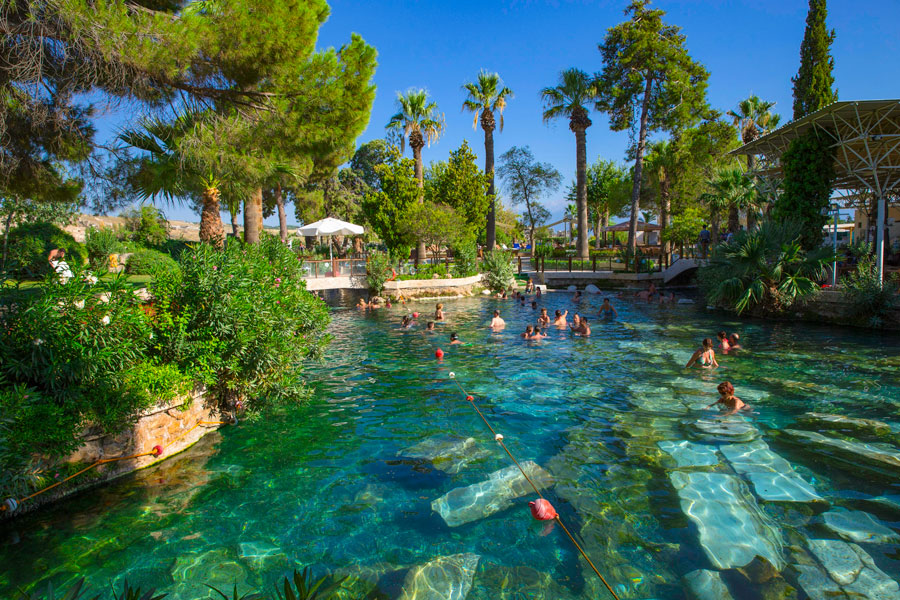
Swim In the Pamukkale Antique Pool
Located within Hierapolis’ Great Baths, the Cleopatra or Sacred Pool (Kleopatra Havuzu) is a must-visit for anyone exploring the top Pamukkale sights. It is believed that the legendary queen visited the site for healing purposes. Its thermal waters, rich in minerals, have been used to rejuvenate skin and muscles since antiquity.
Pro Tip: The pool has a separate entrance fee, and early morning is the best time to enjoy before the crowds arrive.
Pamukkale Natural Park
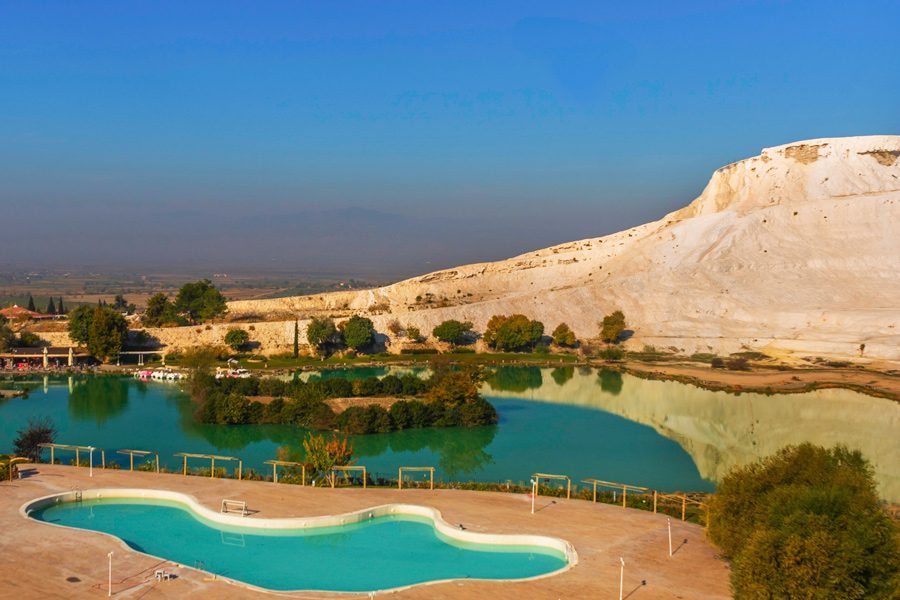
Relax by the Ponds and Relish the View of the Cotton Castle
A peaceful green area with ponds, cafés, and picnic spots at the foot of the terraced basins is called the Pamukkale Natural Park (Pamukkale Tabiat Park). Visitors can rest before or after visiting the Pamukkale hot springs or a museum. The park promises beautiful panoramas of white slopes, suited to photography and quiet breaks. Since the park is free to enter, it is a fantastic addition to your list of free things to do in Pamukkale.
Pro Tip: Walking barefoot is required, and the travertine surface can be uneven – step carefully.
Hierapolis Archaeology Museum
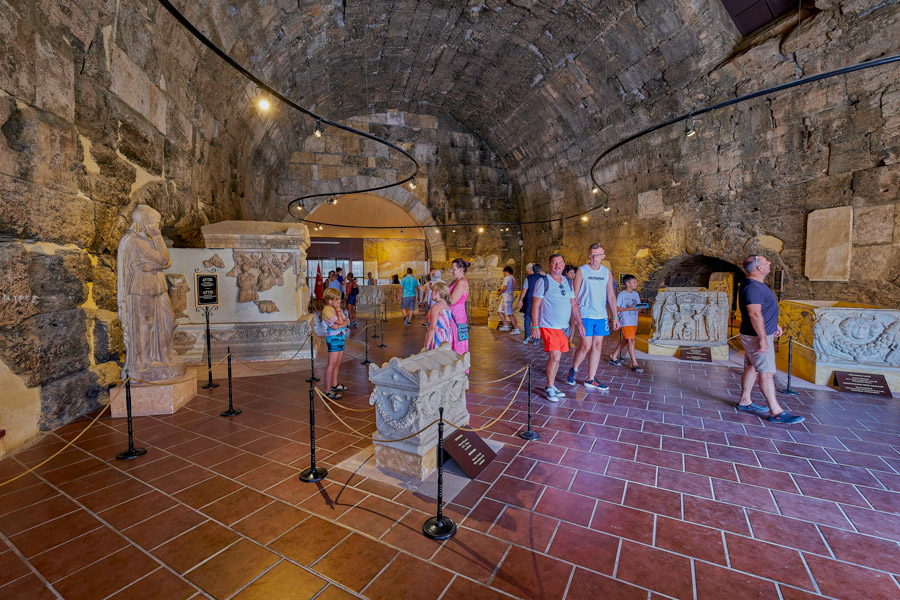
See Ancient Artefacts Inside a Roman Bath Complex
One cannot miss this museum when it comes to the top cultural Pamukkale attractions. Housed inside ancient Roman bath buildings, the Hierapolis Archaeology Museum (Hierapolis Arkeoloji Müzesi) displays sculptures, sarcophagi, and reliefs from the region’s ancient cities. Exhibits from Laodicea, Tripolis, and Colossae complement Hierapolis artefacts, providing context for the civilisations that flourished here.
Pro Tip: You do not need to purchase a separate admission ticket. The general entrance fee for Hierapolis and Pamukkale covers the museum visit.
Pamukkale Sunset Spot
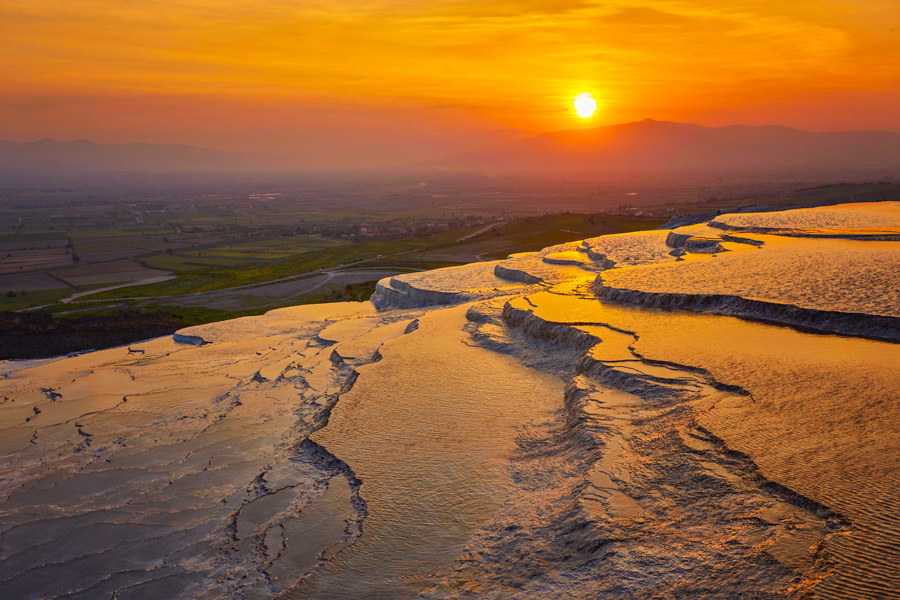
Watch the Cotton Castle Glow at Dusk
One spot in Pamukkale is perfect for sunset. Its coordinates are 37.922866637458974, 29.125222356652237. Thus, when thinking of the top things to do in Pamukkale at night, do not miss this sunset viewpoint overlooking the travertine terraces. The white slopes glitter golden and pink in the twilight, creating a splendid panorama.
Karahayıt Village
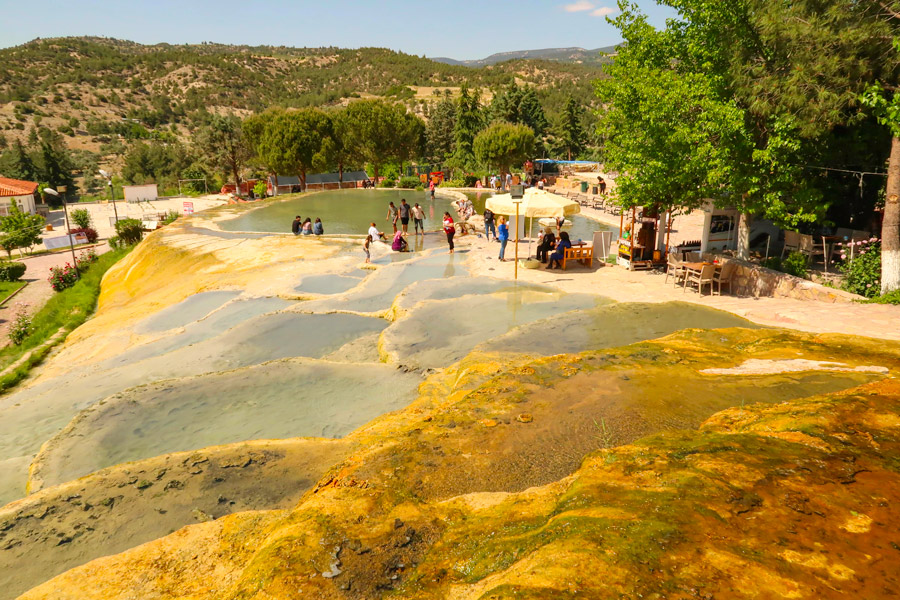
Experience Pamukkale Without Paying
Pamukkale thermal pools are not limited to the popular white lagoons. The nearby village of Karahayıt boasts the so-called Red Springs (Kırmızı Pınarlar). Locals call them “kırmızı su,” which means “red water”. This is a noticeably quiet and untouristy spot. The warm and iron-infused waters are used as natural mud baths for relaxation and detox.
Those keen on the free activities in Pamukkale will appreciate this off-the-beaten-path destination. Besides the springs, the villagers sell honey, herbs, and handmade goods in small markets. Quaint houses and narrow lanes run through the streets, revealing the beauty of local colour.
Halıcı Ahmet Urkay Archaeology and Ethnography Museum
Peruse a Private Collection of Anatolian History
Pamukkale sightseeing will be more exciting if you plan your visit to the Halıcı Ahmet Urkay Archaeology & Ethnography Museum (Halıcı Ahmet Urkay Arkeoloji & Etnografya Müzesi) in Karahayıt. Thousands of historical artefacts alongside everyday objects across Anatolia show rural Turkish life. The museum was founded by the antiquity collector Ahmet Urkay.
Pro Tip: This is a private museum, so the museum card is not accepted. Check out the latest opening status locally before visiting.
Kaklık Cave (Mini Pamukkale)
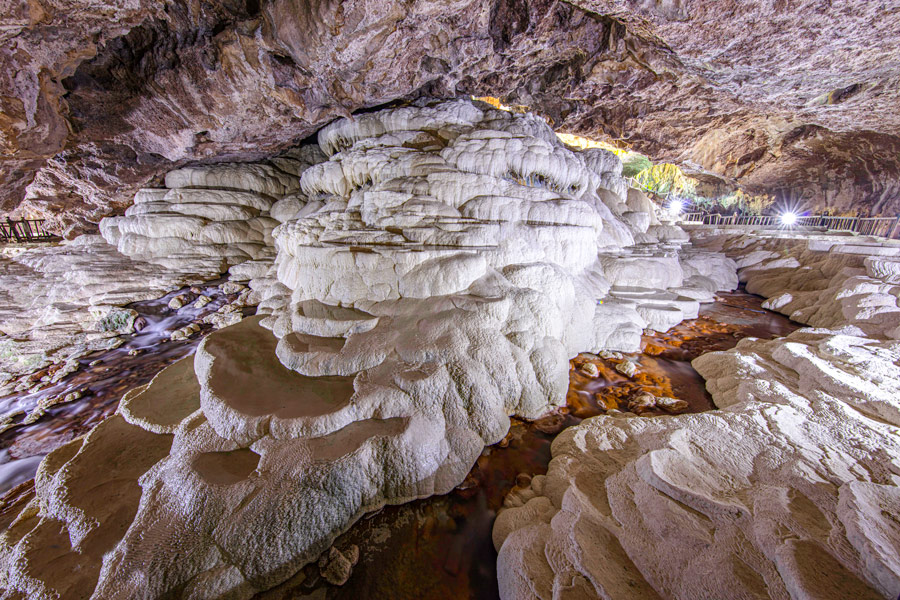
Discover the Subterranean World of Mineral Waters
Tourists are encouraged to take advantage of the day trips from Pamukkale. There are a few Denizli natural wonders that are worth visiting. For example, consider Kaklık Cave (Kaklık Mağarası). Around 40 kilometres from Pamukkale, it sits close to major routes connecting Denizli, Afyon, and Ankara. The nickname “Underground Pamukkale” comes from white travertine formations inside the cave. Its perennial dwellers are dripstones, stalactites, stalagmites, and travertine bright terraces.
Pro Tip: The air has a light sulphur scent, and the floor can be wet – wear comfortable shoes. Entry costs ₺60 (€1.60).
Hot Air Balloon Rides
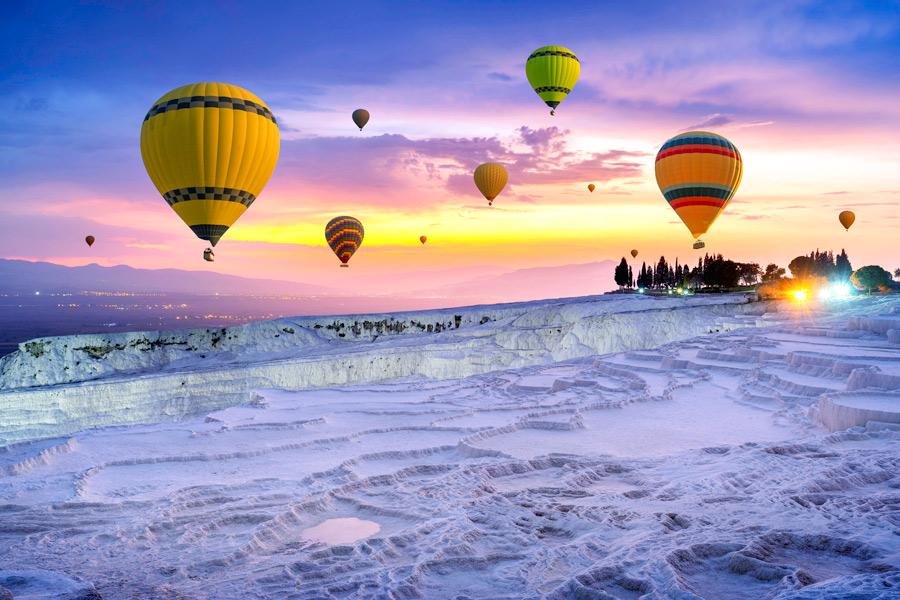
Take a Long Glance at Natural Wonders from Above
While Cappadocia is where hundreds of hot air balloons make their way into the sky, it is not the only place. In that sense, Pamukkale has its own “wows.” After all, the incredible landscape affords an excellent opportunity for unique things to do in Pamukkale. And riding hot air balloons is among them. Visitors can soar high over the white travertine terraces, Hierapolis ruins, and Menderes Valley.
Akhan Caravanserai
Step into Seljuk Heritage on a Pamukkale Tour
The Akhan Caravanserai (Akhan Kervansaray) is an amazing example of Seljuk Architecture. Built in the 13th century, it welcomed traders and travellers along the historic Denizli-Doğubeyazıt Route. It was part of a vast network of roadside inns.
Fifty kilometres from Pamukkale, the Akhan Caravanserai operates today as a restaurant and event venue for weddings and traditional henna nights. Those joining Pamukkale cultural tours can often access the interior with a guide.
Gözler Neighbourhood
Breathe in the Scent of Summer Fields
Free activities in Pamukkale include the escape into nature - the Gözler Lavender Gardens (Gözler Lavanta Bahçeleri). Gözler is a countryside neighbourhood that cultivates these aromatic plants. The gardens bloom in vivid shades from June to August, filling the air with a calming scent. Vacationers in September can even witness the lavender harvest and learn about its use in aromatherapy, perfumes, and natural oils.
Village Shopping

Purchase Authentic Crafts Beyond Denizli
Apart from Denizli’s textile outlets and Pamukkale’s central shops, tourists can opt for a more traditional side of local commerce in Karahayıt and nearby villages. In Karahayıt Village, vendors sell thermal soaps, natural creams, and herbal teas made from the area’s mineral-rich waters and surrounding plants. Seasonal lavender products from Gözler Lavender Gardens, such as essential oils, sachets, and handmade cosmetics, are also popular.
Small roadside stalls between Pamukkale and Hierapolis showcase travertine stone crafts, ceramics, and jewellery. With their souvenirs and sustainable gifts, these quiet markets and family-run stands provide an authentic alternative to Denizli’s busy shopping scene.
Top Things to Do in Pamukkale in One Day
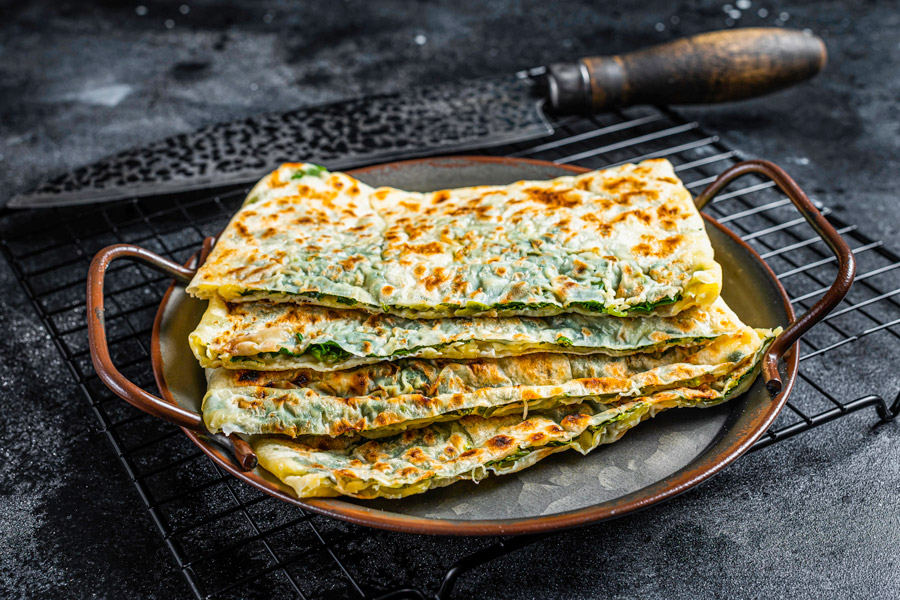
During one day in Pamukkale, visitors can journey through the biggest Pamukkale attractions. The itinerary below incorporates thermal landscapes, Pamukkale historical sites, and a few free things to do in Pamukkale.
Morning: Pamukkale Travertines
Arrive at the Hierapolis-Pamukkale entrance early to avoid crowds and heat. Enter by the northern gate and walk the main travertine slope for the morning light, moving barefoot only in permitted areas; this sequence lets you see the terraces before managers adjust flows or close sections. Spend 60–90 minutes on travertine pools, photographing the Cotton Castle and watching the flow pattern.
Late Morning: Ancient City of Hierapolis
Proceed uphill to Hierapolis ruins, one of the best places to visit in Pamukkale. Allocate 90–120 minutes to the theatre, the agora, the necropolis lanes, and the main bath complex; read stelae in the necropolis to place the city within Roman spa culture. Visit the on-site museum for thirty to forty minutes to view local finds.
Afternoon: Lunch & Antique Pool
Eat at a nearby café or in the village of Pamukkale: regional dishes involve gözleme, grilled meat and seasonal vegetable mezzes that are common in Denizli cuisine. Check out dining spots like Onur Restaurant, Hiera Restaurant Coffee & Tea House, and Mom Eve Restaurant & Pub Wine House. Visitors highly rate these restaurants.
If desired, pay a separate entry fee to Cleopatra’s Pool (Antique Pool) for a swim amid submerged ruins. After bathing, walk to the Pamukkale observation deck for a full view down the terraces across the plain.
Evening: Pamukkale Hot Springs in Karahayıt
If time allows, drive 10–15 minutes to Karahayıt for red mineral waters or return to Denizli for markets. Conclude with sunset photos on the terraces if site hours permit.
Spending Two Days in Pamukkale
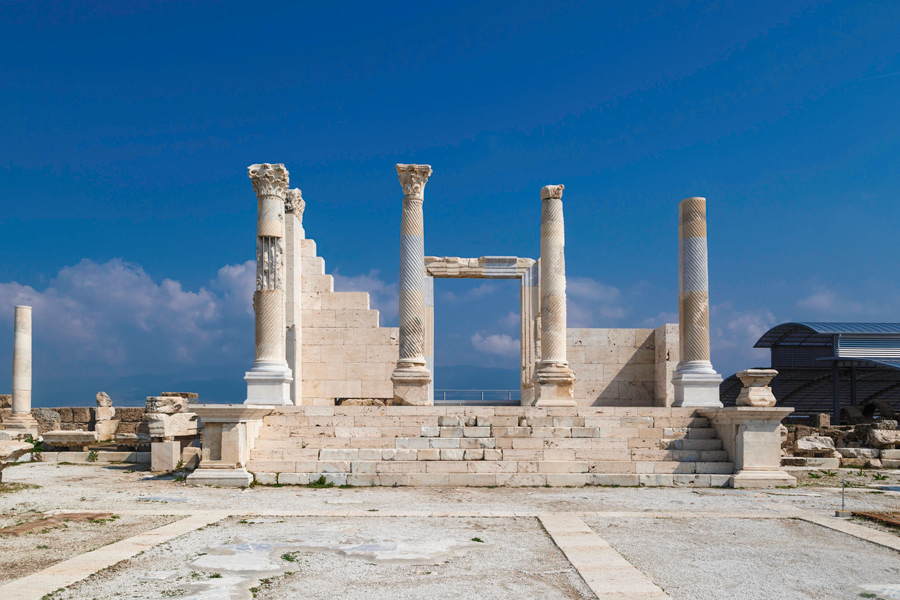
Newcomers spending two days in Pamukkale can follow the itinerary for one day in Pamukkale. Then the second-day itinerary introduces more Pamukkale sights that focus on historic routes and relaxing activities.
Morning: Hot Air Balloon Ride
Begin the second day with a hot air balloon flight over the travertine hot springs. Sunrise rides offer golden light over the white terraces, while sunset flights bring soft evening hues.
Midday: Laodicea Ancient City on the Lycus
After breakfast, embark on short day trips from Pamukkale. Start with the Laodicea Ancient City (Laodikeia Antik Kenti), about 15 minutes (12 kilometres) from the travertines. Once a powerful centre of the Roman Empire, the ancient ruins of theatres, collonaded streets, and basilicas trace the rise of early Christianity in the region. It is a key highlight featured on many Pamukkale cultural tours.
Getting There: Travellers without a car can reach Laodicea Ancient City by taking a dolmuş (minibus) or bus heading toward Denizli, as most routes pass near the site. There are no bus terminals or stations in Pamukkale, but you can catch local buses – 120,121,122, 160 or 390 – from stops located along Adnan Kahveci Boulevard and Mehmet Akif Ersoy Boulevard. For example, one convenient stop is across the textile company İpeknur Tekstil (coordinates: 37.91375, 29.11250). Search Google Maps for “otobüs durağı” (bus stop) to find the nearest pickup points. Still, the fastest and most comfortable option is by taxi or private car, especially if you combine Laodicea with other Pamukkale landmarks on the same day.
Where to eat in Laodicea? Just three minutes from the Laodicea ruins and ten minutes by car from Pamukkale, Harman Restaurant welcomes guests into an interesting setting with spacious outdoor seating. The restaurant specialises in barbecue dishes. Guests can either have meals prepared by the staff or grill their own meat and vegetables.
Afternoon: Akhan Caravanserai or Shopping in Karahayıt
Continue your journey 8 kilometres (11 minutes) to the Akhan Caravanserai. Foreign visitors should ensure beforehand access to the inside. Usually, a Pamukkale guide can arrange that. If the caravanserai is closed, drive 26 minutes to Karahayıt for authentic shopping.
Evening: Thermal Spa Experience
Return to the town and end the day in relaxation. Pamukkale’s thermal spa hotels, such as the Doğa Thermal Health & SPA, render luxurious baths. This soothing sauna is considered among the top things to do in Pamukkale in winter.
Top Things to Do in Pamukkale in Three Days
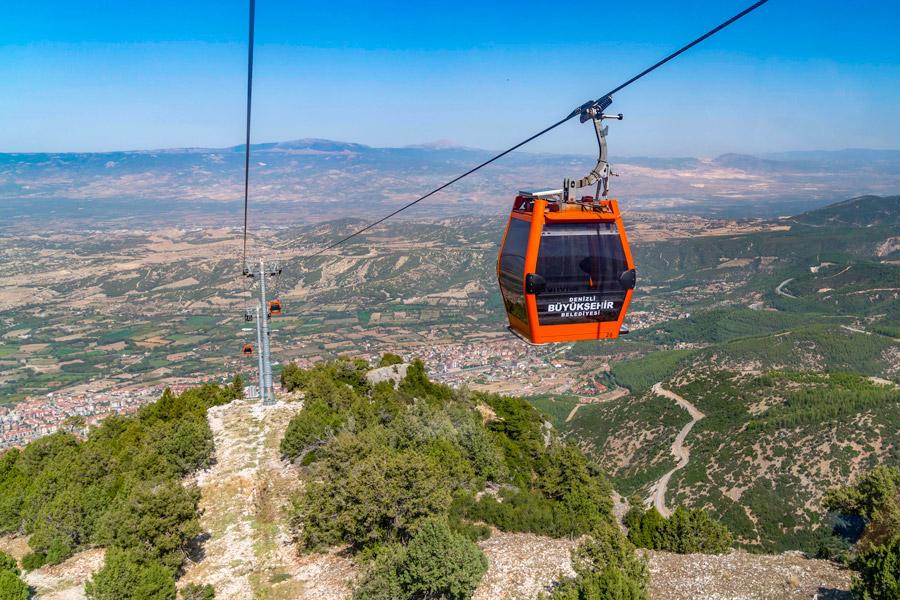
Tourists planning a longer Pamukkale travel can follow the one-day and two-day itineraries for the first two days. This comprises the white travertine terraces, ancient ruins of Hierapolis, Cleopatra pools, Laodicea, and Akhan Caravanserai. The third day reveals nature attractions in Pamukkale and scenic viewpoints.
Morning: Gözler Lavender Gardens
Set off with a visit to the Gözler Lavender Gardens, a draw for travellers seeking seasonal Pamukkale tours. Visitors can stroll the rows, take photos, and purchase locally made lavender products.
Midday: Kaklık Cave and Lunch Stop
Continue for about 30 kilometres to the Kaklık Cave. The cave’s glowing mineral terraces, stalactites, and warm, moist air create an enchanting setting that is a must for Pamukkale sightseeing. There are no restaurants directly at the cave, but the nearby town of Honaz has several eateries ideal for lunch. Try Gençoğlu Büfe Izgara Meşhur Tostçu, famous for its grilled sandwiches, or Demirci Pide ve Yemek Salonu, serving freshly baked pide and traditional Turkish dishes.
Afternoon & Evening: Bağbaşı Plateau Cable Car
Round off your journey with a trip to Denizli, where you can take a cable car to Bağbaşı Plateau (Bağbaşı Yaylası). As dusk approaches, the plateau becomes a serene spot for the sundown vista and relaxed dining – a local favourite for things to do in Pamukkale at night. It is an amazing choice to conclude your three-day Pamukkale travel.
For detailed visitor information, check our Pamukkale Travel Guide.

